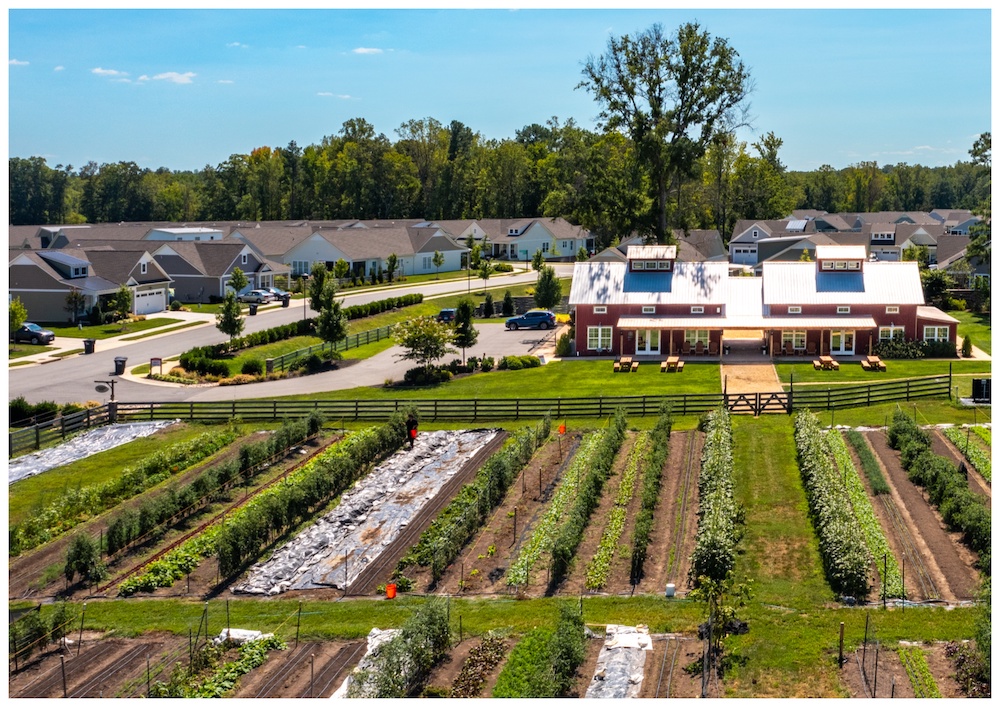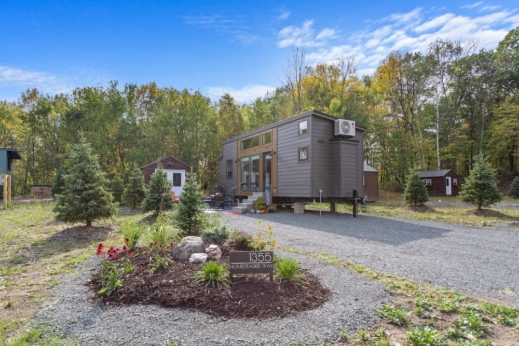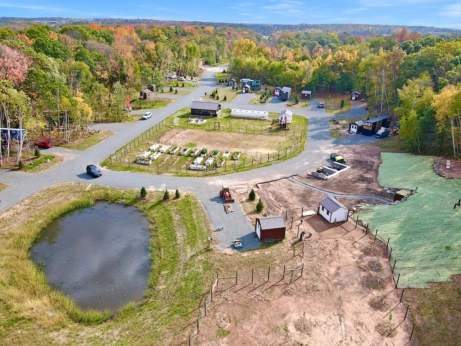Moving into the Agrihood
Planned, farm-centered neighborhoods are on the rise in the United States, offering farm-to-table food and a strong community for residents.
Moving into the Agrihood
Planned, farm-centered neighborhoods are on the rise in the United States, offering farm-to-table food and a strong community for residents.

Chickahominy Falls includes a 10-acre farm and housing for residents 55 and over.courtesy of Chickahominy Falls.
Outside of Charleston, South Carolina, in the picturesque marshes of the Kiawah River, sits more than 100 acres of working farmland. Seasonal crops rotate through expansive pastures, cattle graze the rich sea grasses and several colonies of bees hurry about their business. But unlike neighboring farms that focus on production for faraway markets or keep a single family afloat, the farm at Kiawah River is supporting 185 families who live in the surrounding homes.
Kiawah River is an “agrihood”—a planned community with a working farm at its center. Residents may work or volunteer at the farm, or they may participate in a residents CSA program or visit their own farmer’s market. Kiawah River worked with established farms to begin its agrihood, building a community around preexisting farmland. Its farm partners include fourth-generation Freeman Farms and second-generation Rosebank Farms, along with several others.
Other agrihoods establish farms as central hubs when planning the community. Chickahominy Falls is located outside of Richmond, VA, in what is known as the French hay district, an area that has traditionally been farmland. The agrihood there is for residents 55 and over, and 10-acre Woodside Farms provides a gathering space, volunteer and working opportunities and a CSA.
Tiny Timbers is a small agrihood in St. Croix Falls, WI, a small city on the border near Minneapolis, MN. Its agrihood model uses tiny homes as the residences, with 11 families currently sharing the responsibilities of gardening and caring for the chickens, honey bees and orchards. The community was started by a husband-and-wife team, inspired by a passion for tiny homes and good food. They broke ground on their first houses in the spring of 2023, and they will complete their agrihood with 16 homes.
“Unlike many agrihoods that have a farmer on the edge of the development, ours is all resident operated,” says Melissa Jones, founder of Tiny Timbers. “So, they are personally getting their hands dirty.”

Agrihoods are not a new phenomenon, but their presence has grown in the United States in recent years. According to a report by the Urban Land Institute, in 2018, there were more than 200 agrihoods in 28 states. The concept may seem similar to a commune, but agrihoods are not based around shared politics or religion but focus on fresh food and strong communities. Participation requirements on the farms vary. Many agrihoods offer volunteer opportunities on the farm for residents, but they do not require any participation in farming.
The Urban Land Institute considers agrihoods a valuable trend, helping to solve several issues within the US housing market. With 73 percent of Americans considering access to fresh and healthy food a priority, agrihood living puts residents in the middle of healthy food production. An agrihood’s investment in farmland can help save a family farm and keep more farmland in production. Revenue from the sales of agrihood properties can directly support farms when an agrihood is established, and even working farms near agrihoods that are not involved in the communities can see the value of their farmland rise when an agrihood is built nearby. Building a community around a farm will also save farmers shipping costs and reduce greenhouse gas emissions as produce no longer needs to be transported over long distances.
The agrihood model may harken back to communes or even colonial villages, but if you find yourself wondering “why now?”—the answer may be as simple as reliable access to great food.
“The people here are so kind and fun,” says Danna Berg, a resident of Kiawah River who moved to the agrihood from St. Petersburg, FL in 2021. “I had heard of an agrihood before, but I wasn’t really familiar with the concept. When I stepped foot on the property, I knew it was for me.”
Berg volunteers in the gardens and on the farm at Kiawah River. Every resident we spoke to indicated that the fresh produce was a huge part of the appeal of Kiawah River, from the honey and eggs to the fresh produce and goat’s milk.

In some ways, agrihood living is an idealized version of farm life. At many agrihoods, you won’t have to shovel waste or dig in the dirt if you don’t want to, but you can still enjoy the benefits of local, organic produce grown right outside your door. Even when the residents are involved in the running of the farm, an agrihood can still present a more appealing option than beginning a farm on your own.
Those interested in growing their own food to any scale need to invest in farmland, and access to suitable and affordable farmland is the greatest barrier to young farmers getting started. In an agrihood, access to the land is guaranteed and does not come with the risks of beginning a new family farm.
“A lot of people want to live a healthier lifestyle and be involved with where their food comes from,” says Jones. “But farming can be a lonely, overwhelming task. So, having a community where people can learn from each other, tackle the areas of the agrihood they are skilled in, it helps everyone have a healthier, more fulfilling existence—and make friendships along the way.”
“The eggs are simply amazing,” says Lindsay Cobb. She and her husband Charlie moved to Kiawah River in 2021. When they moved, they had not heard of an agrihood, but they loved the idea of living near a farm and being part of the community events that Kiawah River hosts.
“Access to the fresh vegetables is so unique,” Cobb adds. For farmers, access to fresh vegetables may be a given. But for many Americans, the opportunity to enjoy fresh produce is indeed unique. According to the Urban Land Institute report, 16 percent of Americans say that fresh food is not available in their communities.
The majority of agrihoods in the US today are marketed towards a more affluent demographic, with the average home price in an agrihood around $400,000. However, the model can be applied to lower-income housing and more urban developments. Agrihoods opening in Santa Clara, CA and Denver, CO are committed to offering affordable housing as part of their planned community. At Tiny Timbers, the tiny house model allows most residents to own their homes debt free.

The farms around which agrihoods center face the same challenges as any other agricultural establishment. They can be adversely affected by weather, pests and predators, impacting their ability to supply the community. Some agrihood farms choose to focus on vegetable production to avoid the smells and noises of livestock, which can limit diversity of agrihood-produced goods.
As they address housing needs in a local area, provide healthy food to residents and foster a connection between people and food production, agrihoods seem to offer solutions to numerous challenges. And while a healthy diet often brings residents to an agrihood, residents say that community is what makes them love agrihood living.
“The community here is top notch,” explains Barbara Viverito, who has lived at Kiawah River agrihood since August of 2020. “I have never seen a group of people so friendly.”
While they come in all shapes and sizes, the future of agrihoods may be with individuals like Melissa and Shane Jones at Tiny Timbers. Five years after purchasing a plot of land in 2017, they decided to do something more than just homestead for themselves.
“We have a tiny cabin that we love,” says Melissa Jones, “and my husband has a passion for homesteading—so why not combine those things and create a place where people can live lightly, often debt free, and have the ability to grow healthy, organic food? They can live a healthier lifestyle and be around people that have similar interests.”
Follow us

This work is licensed under a Creative Commons Attribution-NoDerivatives 4.0 International License.
Want to republish a Modern Farmer story?
We are happy for Modern Farmer stories to be shared, and encourage you to republish our articles for your audience. When doing so, we ask that you follow these guidelines:
Please credit us and our writers
For the author byline, please use “Author Name, Modern Farmer.” At the top of our stories, if on the web, please include this text and link: “This story was originally published by Modern Farmer.”
Please make sure to include a link back to either our home page or the article URL.
At the bottom of the story, please include the following text:
“Modern Farmer is a nonprofit initiative dedicated to raising awareness and catalyzing action at the intersection of food, agriculture, and society. Read more at <link>Modern Farmer</link>.”
Use our widget
We’d like to be able to track our stories, so we ask that if you republish our content, you do so using our widget (located on the left hand side of the article). The HTML code has a built-in tracker that tells us the data and domain where the story was published, as well as view counts.
Check the image requirements
It’s your responsibility to confirm you're licensed to republish images in our articles. Some images, such as those from commercial providers, don't allow their images to be republished without permission or payment. Copyright terms are generally listed in the image caption and attribution. You are welcome to omit our images or substitute with your own. Charts and interactive graphics follow the same rules.
Don’t change too much. Or, ask us first.
Articles must be republished in their entirety. It’s okay to change references to time (“today” to “yesterday”) or location (“Iowa City, IA” to “here”). But please keep everything else the same.
If you feel strongly that a more material edit needs to be made, get in touch with us at [email protected]. We’re happy to discuss it with the original author, but we must have prior approval for changes before publication.
Special cases
Extracts. You may run the first few lines or paragraphs of the article and then say: “Read the full article at Modern Farmer” with a link back to the original article.
Quotes. You may quote authors provided you include a link back to the article URL.
Translations. These require writer approval. To inquire about translation of a Modern Farmer article, contact us at [email protected]
Signed consent / copyright release forms. These are not required, provided you are following these guidelines.
Print. Articles can be republished in print under these same rules, with the exception that you do not need to include the links.
Tag us
When sharing the story on social media, please tag us using the following: - Twitter (@ModFarm) - Facebook (@ModernFarmerMedia) - Instagram (@modfarm)
Use our content respectfully
Modern Farmer is a nonprofit and as such we share our content for free and in good faith in order to reach new audiences. Respectfully,
No selling ads against our stories. It’s okay to put our stories on pages with ads.
Don’t republish our material wholesale, or automatically; you need to select stories to be republished individually.
You have no rights to sell, license, syndicate, or otherwise represent yourself as the authorized owner of our material to any third parties. This means that you cannot actively publish or submit our work for syndication to third party platforms or apps like Apple News or Google News. We understand that publishers cannot fully control when certain third parties automatically summarize or crawl content from publishers’ own sites.
Keep in touch
We want to hear from you if you love Modern Farmer content, have a collaboration idea, or anything else to share. As a nonprofit outlet, we work in service of our community and are always open to comments, feedback, and ideas. Contact us at [email protected].by Kirsten Lie-Nielsen, Modern Farmer
December 13, 2023
Modern Farmer Weekly
Solutions Hub
Innovations, ideas and inspiration. Actionable solutions for a resilient food system.
ExploreExplore other topics
Share With Us
We want to hear from Modern Farmer readers who have thoughtful commentary, actionable solutions, or helpful ideas to share.
SubmitNecessary cookies are absolutely essential for the website to function properly. This category only includes cookies that ensures basic functionalities and security features of the website. These cookies do not store any personal information.
Any cookies that may not be particularly necessary for the website to function and are used specifically to collect user personal data via analytics, ads, other embedded contents are termed as non-necessary cookies.
I just watched this documentary- another fabulous idea! Transforming old apartment complexes!
https://youtu.be/iCGXVk-cBVk
Would love to see some interviews with farmers of these agrihoods as a follow-up! I run a small regenerative farm as part of an agrihood in Baja California Sur, Mexico. In our context, we struggle to find skilled farm labor and a balanced agreement between the farm and the HOA for sharing the costs of running the farm – the property’s main amenity. Love seeing this concept being highlighted!
It is a nice idea
This can be done on a smaller more intensive scale. Incorporate small animals, fish, fruit trees surrounding the space and volunteer labor. I describe models in my book, A Radiant Earth.
This is a Transition Towns concept finally coming to the USA.
This is a really cool idea. I would love to do this at my farm, but my wife and I had to stretch to even afford the 25 acres we bought because land is so expensive in Iowa. We certainly don’t have the space to accommodate other farmers, even with growing the higher value crops we do (chestnuts and pawpaws) But if I won the lottery I would absolutely try to buy a neighboring parcel and create a community for beginning farmers. One big drawback to rural living is the lack of neighborhood kids I had growing up in suburbia… Read more »
AGRIHOOD not only provides fresh food but also eliminates CLIMATE CHANGE.
Love that agrihoods are getting some/your attention and being written about, but you guys missed several large, established agrihoods! I’m surprised ULI (Urban Land Institute) didn’t steer you towards them.
Prairie Crossing https://prairiecrossing.com/ ; Willowsford https://willowsfordconservancy.org/ ; Montava & Native Hill https://www.montava.com/ ; Serenbe https://www.serenbe.com/
Was this a paid propmo for Kiawah River?
Similar setup in Mexico at the beautiful Flora Farms community.
I know the article mentions colonial community models, but this sounds very much like a kibbutz to me. I love it.